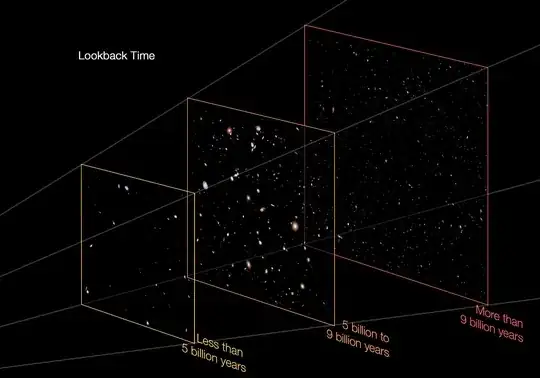Other answers have detailed exactly what the mechanism is, or have given analogies that demonstrate similar principles, but I wanted to find a better visual representation of what's going on. Unfortunately I wasn't able to find exactly what I'm envisioning, but I got pretty close:

So what are we looking at here? Well, picture the Hubble (or technically any telescope) being on the left, taking a peek at a section of the sky. The whole image that you see through it would be all three of these "planes" combined, it would look like one flat picture. But we know intuitively that not all of them are the same distance from us, so hook that into knowing that light takes time to travel any distance, just like everything else, and you might make the connection that you're looking for.
The light from the closer objects that you're seeing (the left plane in the image) is "newer", in that it took less time to reach you. The light from the farthest objects (the right plane) is "older", having taken a longer time to travel the distance from the source to you. So with that in mind, take another look at the diagram and try to visualize a snapshot of space the same way. Any random view of space works. The light is all arriving at your eye at the same time, but some of it was emitted recently, while some was emitted way further in the past and took a longer time to reach you. Thus you are never seeing things as they are "now" but how they were X number of years ago (X correlating with their distance from you). This is where the term "light-year" comes from. If an object is 1 light-year away, it took the light from it 1 year to reach you. In the diagram that translates to the objects in the left frame being about 0 to 5 billion light-years away, the right frame showing objects that are more than 9 billion light-years away, and the middle being somewhere in between.
That's why telescopes can "see back in time". That phrase is somewhat misleading, because it sort-of implies that they can see things in the present too, which they technically can't. But what it really means is that the farther you can see, the further back in time you are looking. That's part of the reason we're obsessed with building longer-range telescopes, to get a better idea of what the universe looked like further in the past.
Edit: I just remembered an episode of Cosmos (the new version) that deals with this topic, though it delves into the space-time side of things a little deeper. It has a decent explanation of why a telescope can "see back in time" and then goes into explaining the relationship between light and time, and the history of how we discovered it. If you have Netflix you can watch it now, or you might be able to find it through other services. The episode is called "A Sky Full of Ghosts".
